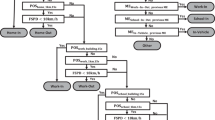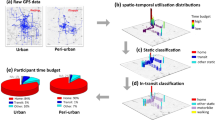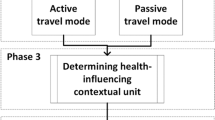Abstract
Because of the spatiotemporal variability of people and air pollutants within cities, it is important to account for a person’s movements over time when estimating personal air pollution exposure. This study aimed to examine the feasibility of using smartphones to collect personal-level time–activity data. Using Skyhook Wireless’s hybrid geolocation module, we developed “Apolux” (Air, Pollution, Exposure), an AndroidTM smartphone application designed to track participants’ location in 5-min intervals for 3 months. From 42 participants, we compared Apolux data with contemporaneous data from two self-reported, 24-h time–activity diaries. About three-fourths of measurements were collected within 5 min of each other (mean=74.14%), and 79% of participants reporting constantly powered-on smartphones (n=38) had a daily average data collection frequency of <10 min. Apolux’s degree of temporal resolution varied across manufacturers, mobile networks, and the time of day that data collection occurred. The discrepancy between diary points and corresponding Apolux data was 342.3 m (Euclidian distance) and varied across mobile networks. This study’s high compliance and feasibility for data collection demonstrates the potential for integrating smartphone-based time–activity data into long-term and large-scale air pollution exposure studies.
This is a preview of subscription content, access via your institution
Access options
Subscribe to this journal
Receive 6 print issues and online access
$259.00 per year
only $43.17 per issue
Buy this article
- Purchase on Springer Link
- Instant access to full article PDF
Prices may be subject to local taxes which are calculated during checkout


Similar content being viewed by others
References
Brook RD . Is air pollution a cause of cardiovascular disease? Updated review and controversies. Rev Environ Health 2007; 22 (2): 115–137.
Chen H, Goldberg M, Villeneuve P . A systematic review of the relation between long-term exposure to ambient air pollution and chronic diseases. Rev Environ Health 2008; 23 (4): 243.
Englert N . Fine particles and human health — a review of epidemiological studies. Toxicol Lett 2004; 149 (1): 235–242.
Pelucchi C, Negri E, Gallus S, Boffetta P, Tramacere I, La Vecchia C . Long-term particulate matter exposure and mortality: a review of European epidemiological studies. BMC Public Health 2009; 9 (1): 453.
Stillerman KP, Mattison DR, Giudice LC, Woodruff TJ . Environmental exposures and adverse pregnancy outcomes: a review of the science. Reprod Sci 2008; 15 (7): 631–650.
Huang Y-L, Batterman S . Residence location as a measure of environmental exposure: a review of air pollution epidemiology studies. J Expos Anal Environ Epidemiol 2000; 10 (1): 66.
Jerrett M, Arain A, Kanaroglou P, Beckerman B, Potoglou D, Sahsuvaroglu T et al. A review and evaluation of intraurban air pollution exposure models. J Expos Sci Environ Epidemiol 2004; 15 (2): 185–204.
Klepeis NE, Nelson WC, Ott WR, Robinson JP, Tsang AM, Switzer P et al. The National Human Activity Pattern Survey (NHAPS: a resource for assessing exposure to environmental pollutants. J Expos Anal Environ Epidemiol 2001; 11 (3): 231–252.
Wallace L, Nelson W, Ziegenfus R, Pellizzari E, Michael L, Whitmore R et al. The Los Angeles TEAM Study: personal exposures, indoor–outdoor air concentrations, and breath concentrations of 25 volatile organic compounds. J Expos Anal Environ Epidemiol 1991; 1 (2): 157.
Zhu Y, Hinds WC, Kim S, Sioutas C . Concentration and size distribution of ultrafine particles near a major highway. J Air Waste Manage Assoc 2002; 52 (9): 1032–1042.
Elgethun K, Yost MG, Fitzpatrick CT, Nyerges TL, Fenske RA . Comparison of Global Positioning System (GPS tracking and parent-report diaries to characterize children's time–location patterns. J Expos Sci Environ Epidemiol 2006; 17 (2): 196–206.
Shy CM, Kleinbaum DG, Morgenstern H . The effect of misclassification of exposure status in epidemiological studies of air pollution health effects. Bull NY Acad Med 1978; 54 (11): 1155.
Dons E, Int Panis L, Van Poppel M, Theunis J, Willems H, Torfs R et al. Impact of time–activity patterns on personal exposure to black carbon. Atmos Environ 2011; 45 (21): 3594–3602.
Bellander T, Wichmann J, Lind T . Individual exposure to NO2 in relation to spatial and temporal exposure indices in Stockholm, Sweden: the INDEX study. PLoS One 2012; 7 (6): e39536.
Hystad P, Demers PA, Johnson KC, Brook J, van Donkelaar A, Lamsal L et al. Spatiotemporal air pollution exposure assessment for a Canadian population-based lung cancer case–control study. Environ Health 2012; 11 (1): 22.
Harrison R, Thornton CA, Lawrence RG, Mark D, Kinnersley RP, Ayres JG . Personal exposure monitoring of particulate matter, nitrogen dioxide, and carbon monoxide, including susceptible groups. Occup Environ Med 2002; 59 (10): 671–679.
Arku RE, Vallarino J, Dionisio KL, Willis R, Choi H, Wilson JG . Characterizing air pollution in two low-income neighborhoods in Accra, Ghana. Sci Total Environ 2008; 402 (2): 217–231.
Nethery E, Leckie SE, Teschke K, Brauer M . From measures to models: an evaluation of air pollution exposure assessment for epidemiological studies of pregnant women. Occup Environ Med 2008; 65 (9): 579–586.
Greaves S, Issarayangyun T, Liu Q . Exploring variability in pedestrian exposure to fine particulates (PM2.5 along a busy road. Atmos Environ 2008; 42 (8): 1665–1676.
Elgethun K, Fenske RA, Yost MG, Palcisko GJ . Time–location analysis for exposure assessment studies of children using a novel Global Positioning System instrument. Environ Health Perspect 2003; 111 (1): 115.
Phillips ML, Hall TA, Esmen NA, Lynch R, Johnson DL . Use of Global Positioning System technology to track subject's location during environmental exposure sampling. J Expos Anal Environ Epidemiol 2001; 11 3: 207–215.
Rainham D, McDowell I, Krewski D, Sawada M . Conceptualizing the healthscape: contributions of time geography, location technologies and spatial ecology to place and health research. Soc Sci Med 2010; 70 (5): 668–676.
Wu J, Jiang C, Liu Z, Houston D, Jaimes G, McConnell R . Performances of different Global Positioning System devices for time–location tracking in air pollution epidemiological studies. Environ Health Insights 2010; 4: 93.
Oulasvirta A, Rattenbury T, Ma L, Raita E . Habits make smartphone use more pervasive. Pers Ubiquit Comput 2012; 16 (1): 105–114.
Liljegren RA, Jensen UL, Nielsen MRW . Performance Evaluation of the Skyhook Wireless Positioning System. The IT University of Copenhagen. Available at: https://blog.itu.dk/SPVC-E2010/files/2011/08/11skyhookperformace.pdf (last accessed 1 May 2013.
Abdulazim T, Abdelgawad H, Nurul Habib KM, Abdulhai B . Using smartphones and sensor technologies to automate collection of travel data. Transportation research record. J Transport Res Board 2013; 2383 (1): 44–52.
Gaumer EBD, Osgood N, Brooks-Gunn J . Opportunities and Challenges for Leveraging Smartphone Technology in Field Studies: A Pilot Study in New York City. Population Association of America: 2014 Annual Meeting Program.
comScore Reports March 2013 US Smartphone Subscriber Market Share. Available at: http://www.comscore.com/Insights/Press_Releases/2013/5/comScore_Reports_March_2013_U.S._Smartphone_Subscriber_Market_Share (last accessed 1 November 2013.
Ward MH, Nuckols JR, Giglierano J, Bonner MR, Wolter C, Airola M et al. Positional accuracy of two methods of geocoding. Epidemiology 2005; 16 (4): 542–547.
Cayo MR, Talbot TO . Positional error in automated geocoding of residential addresses. Int J Health Geogr 2003; 2 (1): 10.
Song G-S . Examination of accuracy and efficiency of the GPS as a shipboard navigator up to early 1992 in Taiwan Region. Acta Oceanogr Taiwan (28 1992; 28: 102–117.
Breen MS, Long TC, Schultz BD, Crooks J, Breen M, Langstaff JE et al. GPS-based microenvironment tracker (MicroTrac model to estimate time–location of individuals for air pollution exposure assessments: Model evaluation in central North Carolina. J Expos Sci Environ Epidemiol 2014; 24 (4): 412–420.
Zandbergen PA . Accuracy of iPhone locations: a comparison of assisted GPS, WiFi and cellular positioning. Trans GIS 2009; 13 (Suppl 1): 5–25.
Zandbergen PA . Comparison of WiFi positioning on two mobile devices. J. Location Based Services 2012; 6 (1): 35–50.
Meniem MHA, Hamad AM, Shaaban E . Fast and accurate practical positioning method using enhanced-lateration technique and adaptive propagation model in GSM mode. Int J Comput Sci 2012; 9 (2): 9.
Skyhook: How It Works. Available at http://www.skyhookwireless.com/howitworks/ (last accessed 1 August 2013).
Skyhook Loses A Big Fish — Apple. Available at: http://blogs.wsj.com/digits/2010/07/30/skyhook-loses-a-big-fish-apple/ (last accessed 1 August 2013.
Gallagher T, Li B, Kealy A, Dempster AG . Trials of commercial Wi-Fi positioning systems for indoor and urban canyons. IGNSS 2009 Symposium on GPS/GNSS, Citeseer, Holiday Inn Surfers Paradise, Queensland, Australia, 2009.
Cheng Y-C, Chawathe Y, LaMarca A, Krumm J . Accuracy characterization for metropolitan-scale Wi-Fi localization. Proceedings of the Third International Conference on Mobile systems, Applications, and Services, ACM, Seattle, Washington, USA, 2005.
King T, Haenselmann T, Effelsberg W . Deployment, calibration, and measurement factors for position errors in 802.11-based indoor positioning systems. In: Jeffrey Hightower, Bernt Schiele, Thomas Strang (eds. Location-and Context-Awareness Berlin Springer. 2007, pp 17–34.
Chang N, Rashidzadeh R, Ahmadi M . Robust indoor positioning using differential wi-fi access points. IEEE Trans Consumer Electron 2010; 56 (3): 1860–1867.
Feng C, Anthea Au WS, Valaee S, Tan Z . Compressive sensing based positioning us ing RSS of WLAN access points. INFOCOM, 2010 Proceedings IEEE, IEEE, 2010, San Diego, California, USA..
Kim M, Fielding JJ, Kotz D . Risks of using AP locations discovered through war driving. In: Kenneth P. Fishkin, Bernt Schiele, Paddy Nixon, Aaron Quigley (eds. Pervasive Computing Berlin Springer. 2006, pp 67–82.
Palmer JB, Espenshade TJ, Bartumeus F, Chung CY, Ozgencil NE, Li K . New approaches to human mobility: using mobile phones for demographic research. Demography 2013; 50 (3): 1105–1128.
Hu S, Fruin S, Kozawa K, Mara S, Paulson SE, Winer AM et al. A wide area of air pollutant impact downwind of a freeway during pre-sunrise hours. Atmos Environ 2009; 43 (16): 2541–2549.
Wiehe SE, Carroll AE, Liu GC, Haberkorn KL, Hoch SC, Wilson JS et al. Using GPS-enabled cell phones to track the travel patterns of adolescents. Int J Health Geogr 2008; 7 (1): 22.
Song C, Qu Z, Blumm N, Barabási AL . Limits of predictability in human mobility. Science 2010; 327 (5968): 1018–1021.
Acknowledgements
This study was supported by the National Institute of Environmental Health Sciences (grant no.: 5R21ES017826) and the National Cancer Institute (R25T CA113951). We thank the staff of the Women’s Health Initiative Study in the Department of Epidemiology and Environmental Health, University at Buffalo, The State University of New York.
Author information
Authors and Affiliations
Corresponding author
Ethics declarations
Competing interests
The authors declare no conflict of interest.
Rights and permissions
About this article
Cite this article
Glasgow, M., Rudra, C., Yoo, EH. et al. Using smartphones to collect time–activity data for long-term personal-level air pollution exposure assessment. J Expo Sci Environ Epidemiol 26, 356–364 (2016). https://doi.org/10.1038/jes.2014.78
Received:
Revised:
Accepted:
Published:
Issue Date:
DOI: https://doi.org/10.1038/jes.2014.78
Keywords
This article is cited by
-
Personal exposure monitoring using GPS-enabled portable air pollution sensors: A strategy to promote citizen awareness and behavioral changes regarding indoor and outdoor air pollution
Journal of Exposure Science & Environmental Epidemiology (2023)
-
Automated classification of time-activity-location patterns for improved estimation of personal exposure to air pollution
Environmental Health (2022)
-
Wireless muometric navigation system
Scientific Reports (2022)
-
On the potential of iPhone significant location data to characterize individual mobility for air pollution health studies
Frontiers of Environmental Science & Engineering (2022)
-
Citizen sensors for smart city planning and traffic management: crowdsourcing geospatial data through smartphones in Jeddah, Saudi Arabia
GeoJournal (2022)



